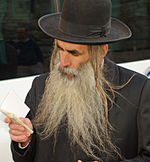Payot
| Payot | |
|---|---|
 Orthodox Jewish man with untrimmed beard and peyes פְּאַ֖ת Pe'at | |
| Halakhic texts relating to this article: | |
| Torah: | Leviticus 19:27 |
| Babylonian Talmud: | Makkoth 20a |
| Mishneh Torah: | Avodath Kokhavim 12:6 |
| Shulchan Aruch: | Yoreh Deah 181 |
| * Not meant as a definitive ruling. Some observances may be rabbinical, customs or Torah based. | |
Payot (also pe'ot, peyot, payos, payess, peyess, peyos Hebrew: singular, פֵּאָה; plural, פֵּאוֹת At Yemeni jewish it is called 'Simonim' too סִימָנִים) is the Hebrew word for sidelocks or sidecurls. Payot are worn by some men and boys in the Orthodox Jewish community based on an interpretation of the Biblical injunction against shaving the "corners" of one's head. Literally, pe'ah means corner, side or edge. There are different styles of payes among Haredi, Yemenite, and Hasidic Jews. Yemenite Jews called their sidelocks simanim, literally signs, because their long curled sidelocks served as a distinguishing feature in Yemenite society.
Rabbinical interpretation
The Torah says, "You shall not round off the פְּאַ֖ת Pe'at of your head" (Leviticus 19:27). The word Pe'at was taken to mean the hair in front of the ears extending to beneath the cheekbone, on a level with the nose (Talmud - Makkot 20a). The Mishnah interpreted the regulation as applying only to men. Thus it became the custom in certain circles to allow the hair over the ears to grow, and hang down in curls or ringlets. According to Maimonides, cutting the sidelocks was a heathen practice. There is considerable discussion in the halachic literature as to the precise location of the payot and of the ways in which their removal is prohibited.
History
From a mystical perspective, payot were believed to separate the front part of the brain, used for abstract thought, from the back part of the brain that governs the body. As kabbalistic teachings spread into Slavonic lands, the custom of payot became entrenched, even though Tzar Nicholas I forbade the practice in Russia in 1845. In the Crimea, Crimean Karaites did not wear peyos, and the Crimean Tatars consequently referred to them as zulufsız çufutlar, meaning Jews without peyos, to distinguish them from the Krymchaks, referred to as zuluflı çufutlar, meaning Jews with peyos. The Hasidic and Yemenite Jews let their sidelocks grow particularly long. Some Haredi men grow sidelocks, but keep them short or tuck them behind the ears. Even among Jewish groups in which the men do not wear noticeable peyos, often the young boys do wear them until around the age of Bar Mitzva.
Styles
The Lithuanian Jews were less influenced by Kabbalistic practises, but still retain sidelocks to a degree, in a small number of variant styles:
See also
References
Retrieved from : http://en.wikipedia.org/wiki/Payot